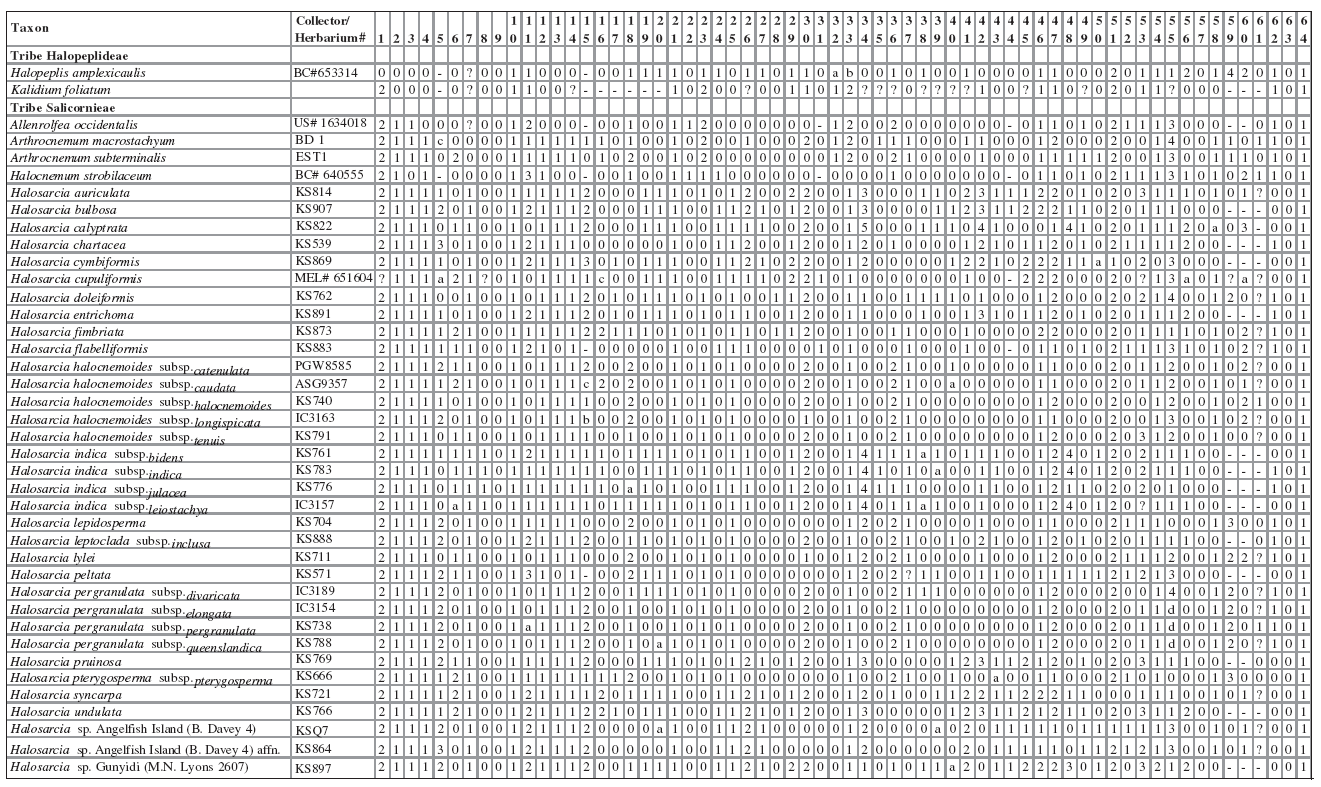Incorporation of the Australian genera Halosarcia, Pachycornia, Sclerostegia and Tegicornia into Tecticornia (Salicornioideae, Chenopodiaceae)
Kelly A. Shepherd A B C and Paul G. Wilson AA Western Australian Herbarium, Department of Environment and Conservation, Science Division, Locked Bag 104, Bentley Delivery Centre, WA 6983, Australia.
B School of Plant Biology, The University of Western Australia, 35 Stirling Highway, Crawley, WA 6065, Australia.
C Corresponding author. Email: Kelly.Shepherd@dec.wa.gov.au
Australian Systematic Botany 20(4) 319-331 https://doi.org/10.1071/SB07002
Submitted: 12 January 2007 Accepted: 8 May 2007 Published: 5 September 2007
Abstract
Recent molecular and morphological studies have shown that the genera Halosarcia, Pachycornia, Sclerostegia, Tecticornia and Tegicornia are closely related and form a monophyletic group. Support for the monophyly of the individual genera in the group is lacking, with the smaller genera nested in a paraphyletic Halosarcia. In light of this it is proposed that these genera be subsumed into a single genus for which the most appropriate available name is Tecticornia. A conspectus is provided of all species in the expanded Tecticornia, with new combinations given for 30 species and 13 subspecies.
Acknowledgements
The authors sincerely thank Carol Wilkins, Terry Macfarlane and Kevin Thiele for providing invaluable comments on earlier drafts of the manuscript. This research was funded in part through the Department of Environment and Conservation ‘Saving our Species’ project and an ARC linkage grant with the University of Western Australia with support from MERIWA, Normandy Mining Limited, Placer (Granny Smith), Acacia Resources, KCGM and the Western Australian Herbarium. KS thanks the Centre for Microscopy and Microanalysis UWA for providing support and the use of the Sorvall Microtome and Environmental Scanning Electron Microscope.
Black JM
(1919) A revision of the Australian Salicornieae. Transactions of the Royal Society of South Australia 43, 355–367.

Connor HE
(1984) Gynodioecism in Sarcocornia quinqueflora (Salicornieae) in New Zealand. New Zealand Journal of Botany 22, 433–439.

Dalby DH
(1962) Chromosome number, morphology and breeding behaviour in the British Salicornieae. Watsonia 5, 150–162.

Dalby DH
(1963) Seed dispersal in Salicornia pusilla. Nature 199, 197–198.
| Crossref | GoogleScholarGoogle Scholar |

De Fraine E
(1912) The anatomy of the genus Salicornia. Journal of the Linnean Society of Botany 41, 317–346.

Kadereit G,
Gotzek D,
Jacobs S, Freitag H
(2005) Origin and age of Australian Chenopodiaceae. Organisms, Diversity & Evolution 5, 59–80.
| Crossref | GoogleScholarGoogle Scholar |

Kadereit G,
Mucina L, Freitag H
(2006) Phylogeny of Salicornioideae (Chenopodiaceae): diversification, biogeography, and evolutionary trends in leaf and flower morphology. Taxon 55, 617–642.

O’Callaghan M
(1992) The ecology and identification of the southern African Salicornieae (Chenopodiaceae). South African Journal of Botany 58, 430–439.

Scott AJ
(1977) Reinstatement and revision of Salicorniaceae J.Agardh (Caryophyllales). Botanical Journal of the Linnean Society 75, 357–374.

Shepherd KA, Yan G
(2003) Chromosome numbers and size variations in the Australian Salicornioideae (Chenopodiaceae)—evidence of polyploidisation. Australian Journal of Botany 51, 441–452.
| Crossref | GoogleScholarGoogle Scholar |

Shepherd KA,
Waycott M, Calladine A
(2004) Radiation of the Australian Salicornioideae (Chenopodiaceae)—based on evidence from Nuclear and Chloroplast DNA sequences. American Journal of Botany 91, 1387–1397.

Shepherd KA,
Colmer TD, Macfarlane TD
(2005a) Morphology, anatomy and histochemistry of fruits and seeds of the Salicornioideae (Chenopodiaceae). Annals of Botany 95, 917–933.
| Crossref | GoogleScholarGoogle Scholar | PubMed |

Shepherd KA,
Macfarlane TD, Waycott M
(2005b) Phylogenetic analysis of the Australian Salicornioideae (Chenopodiaceae) based on morphology and nuclear DNA. Australian Systematic Botany 18, 89–115.
| Crossref | GoogleScholarGoogle Scholar |

Short DC, Colmer TD
(1999) Salt tolerance in the halophyte Halosarcia pergranulata subsp. pergranulata. Annals of Botany 83, 207–213.
| Crossref | GoogleScholarGoogle Scholar |

Wilson PG
(1972) A taxonomic revision of the genus Tecticornia. Nuytsia 1, 277–288.

Wilson PG
(1980) A revision of the Australian species of Salicornieae (Chenopodiaceae). Nuytsia 3, 1–154.


|



